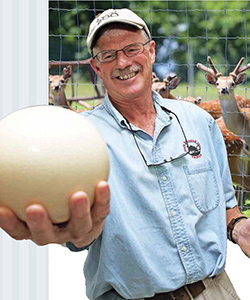
Lives of Consequence
Mark MacNamara ’72, P’00, P’04

Founder, Fauna Research, Inc.
Owner, Highland Deer Farm
On green rolling hills bordered by verdant woodlands, Mark MacNamara’s ’72, P’00, P’04 Highland Deer Farm, a non-traditional 50-acre exotic hoof stock farm in Germantown, N.Y., teems with herds of deer, elk, oryx, ostrich, and bison that roam so free, one may question if the fenced enclosure still exists on the outskirts of the pass.
“The animals at Highland Farm are non-domestic and are managed similarly to wild populations; they have a sense of freedom, but are provided with excellent health care and nutrition,” explains MacNamara.
Protecting the wellbeing of animals has always been a passion for MacNamara, who while at Hobart studied the effects of DDT on thinning osprey eggshells under Professor of Biology Richard Ryan. He went on to earn a master’s in zoology from Oneonta University and was curator of mammals at the Bronx Zoo in Bronx, N.Y. for 10 years before starting Fauna Research Inc. with his wife, Martha Cook MacNamara ’72, P’00, P’04. For the past 25 years, they have been designing, fabricating, supplying and installing the TAMER Systems -- specialized equipment for managing and handling exotic animals in international zoos, game parks and bio-reserves.
“I first thought of creating TAMER Systems as a solution to managing my own hoof stock collection,” MacNamara explains. “Before the TAMER existed, zoo animals were usually tranquilized for routine animal management procedures, often posing risk for injury to the animals once unconscious. It wasn’t long before developing the equipment that we realized how beneficial it could be. It doesn’t matter if the animal is a 2,000 pound giraffe or a 20-pound endangered sand gazelle; we can create a TAMER to fit any breeder or zookeeper’s needs.”
Today, the TAMER System is serving management and breeding programs for mammals, both small and tall, from the inner city conditions of Baltimore to the desert conditions of the Middle East.
“The TAMER System’s portable corral and chutes offer a chemical free system for humanely managing and restraining animals for health maintenance, shipping and testing, while providing safer working conditions for handlers and animals alike,” MacNamara says. “TAMER restraints are made to either hydraulically or mechanically hug or hoist an animal carefully off the ground so as to provide all around access for examiners. With numerous portals and doors in the equipment design, personnel can work simultaneously on an animal, performing different tasks in record time, with unrivaled care and safety.”
Currently, there are more than 70 giraffe TAMERs in use at major zoos worldwide. The giraffe TAMER is used to carry out veterinary procedures such as blood draws, clinical exams and foot care. By training giraffes to be relaxed in the TAMER, MacNamara says, zookeepers are able to reduce stress on the animals, which benefits their welfare. At the Al Ain Zoo in the United Arab Emirates (UAE), the TAMER was used to save a mother giraffe from a potentially lethal postpartum infection. More that 100 different hoof stock species have been treated in TAMER equipment, ranging from water buffalo to Indochinese Sika deer. While MacNamara specializes in hoof stock, he has accommodated a number of other animals over the years, including elephants, rhinos, hippos, cheetahs and bears.
MacNamara is also involved with several desert antelope conservation projects in the Middle East, in the UAE, Qatar, Oman, Jordan and Chad. “It’s a challenge to work in 120 degree heat and under desert conditions,” he says, “but very rewarding to be able to introduce TAMER equipment and modern animal management practices to these remote areas.”
